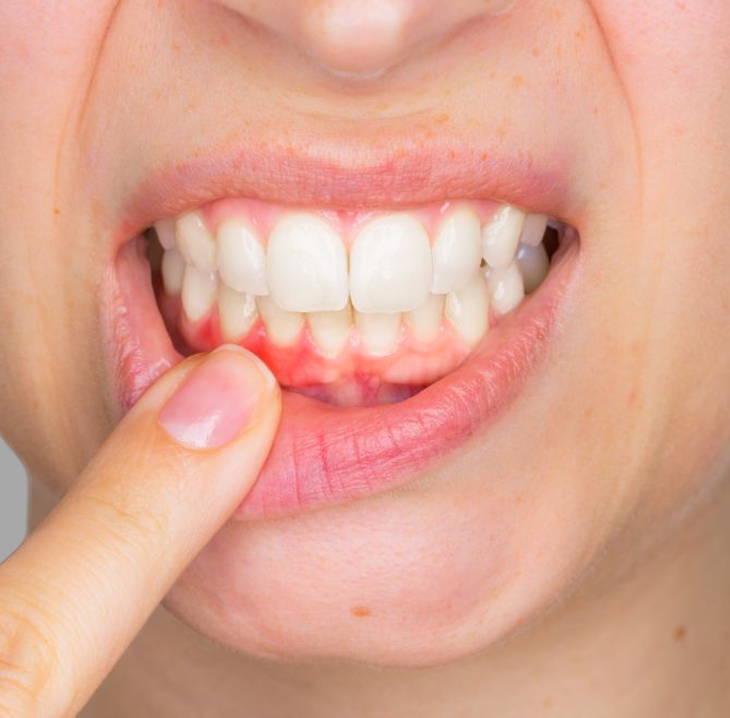
Periodontal Therapy in Hutchinson, KS
Periodontal disease, also known as gum disease, affects approximately 30% of adults and is the leading cause of tooth loss in adults. Many cases of dentures are a result of this chronic condition. While it cannot be cured, it can be controlled with regular professional cleanings and consistent home care.
Gum disease can progress without obvious signs or symptoms. Many patients with this condition do not experience pain and are surprised by the damage it can cause. Think of your gums and bone around your teeth as the foundation of a house - if the foundation is weak, the rest of the house will suffer.
Regular dental check-ups, cleanings, and good home care are crucial for detecting and managing periodontitis effectively.
Gum disease has multiple causes
Our mouths provide a home to millions of bacteria, both beneficial and harmful. Bacterial waste forms a sticky substance, called plaque, which adheres to the teeth. Brushing and flossing remove plaque before it mineralizes into tartar. Tartar becomes a colony for more bacteria releasing toxins into the gums.
Thanks to your immune system, gums react to this bacterial invasion with an inflammatory response. Around the base of each tooth, there is a collar of gum tissue that forms a small pocket. This warm, dark environment provides a perfect habitat for tartar and bacteria to infiltrate.
Early inflammation results in bleeding gums, known as gingivitis. Bacteria left untreated and undisturbed create a chronic infection in the periodontal pocket. In many cases, the bone begins to deteriorate around the teeth. While gums may be slightly tender at this stage, there's generally minimal discomfort as the bone begins to erode.
More than 50% of the bone around your teeth can disappear before you notice any signs of looseness or pain. The bone around teeth never regenerates, so this loss becomes permanent and harder to control as the bacteria hide deeper in the gums. In advanced cases, untreated gum disease leads to abscesses and generalized tooth loss.
Diagnosis
Before diagnosing gum disease, we consider several factors. The depth of the gum pocket around each tooth is typically 2-3 millimeters, easily cleaned with floss or toothpicks. Our team can measure and chart these areas using a periodontal probe. If measurements are over 3 millimeters and bleed, it indicates periodontal disease.
We also assess the texture, shape, and movement of your gums and examine the bone levels, shape, and density around your teeth using digital x-rays. This data helps us understand your gum condition accurately.
Treatment
Once we have determined the severity of your gum disease, we will create a personalized treatment plan. For mild cases with minimal bone loss, a few visits with our hygiene team may be all that is needed to bring the condition under control. With a strategy for daily home care and regular professional maintenance, additional treatment may not be necessary.
If the inflammation has progressed and there is noticeable bone loss, it is important to take a proactive approach to prevent further deterioration. This may involve numbing of the gums and root planing or scaling over several visits to deep clean a portion of your mouth at a time. This process includes removing infected pockets around each tooth and tartar buildup using hand and ultrasonic instruments, followed by polishing to create smooth surfaces that resist staining and plaque buildup.
Dr. Davidson may recommend a medicated rinse, electric or ultrasonic toothbrush, and other specific strategies to assist with your home care routine. It is important to remember that while gum disease can be controlled, it cannot be cured. Consistent home care is essential for managing the disease.
Maintenance is important
It is crucial to maintain regular home care to prevent gum disease from progressing. Bacteria can quickly repopulate and adhere to teeth within hours of cleaning, leading to plaque hardening and mineralizing within 24 hours if left undisturbed. Deeper gum pockets require extra diligence to prevent bacteria from causing damage to the teeth's foundation.
If gum pockets have been previously damaged by bacteria, it may be challenging to clean them effectively at home. A consistent maintenance schedule with us is necessary to address this issue. We can create a customized plan for you, including two, three, or four visits a year based on the severity of the disease, its response to treatment, and your home care routine.
If our efforts do not effectively slow or stop the progression of your gum disease, we may recommend a referral to a periodontist specialist.
Connection between the mouth and body
Recent studies have found a connection between oral bacteria and serious health conditions such as heart disease, stroke, arthritis, Alzheimer's, and certain types of cancer. The impact of a person's oral health on their overall well-being is now better understood than ever before.
When gums bleed, it creates a direct pathway for oral bacteria to enter the bloodstream. Just like an open wound on the skin can lead to infection, bleeding gums should be treated with the same level of concern. This helps to explain why researchers are discovering oral bacteria deposits in various parts of the body.
Individuals with diabetes and other autoimmune disorders have a weakened ability to fight infection, allowing gum disease to progress more rapidly and cause more damage. Additionally, inflammation in the mouth can worsen diabetes, making it harder to manage. This mutual relationship between these chronic conditions underscores the importance of maintaining good oral hygiene.